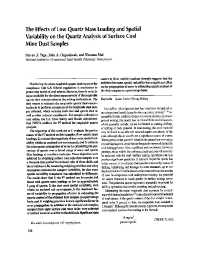Mining Publication: The Effects of Low Quartz Mass Loading and Spatial Variability on the Quartz Analysis of Surface Coal Mine Dust Samples
Original creation date: September 2001
Monitoring the miner respirable quartz dust exposure for compliance with U.S. federal regulations is mandatory to protect the health of coal miners. However, there is no technique available for the direct measurement of the respirable quartz dust concentration in the mining environment. The only means to estimate the respirable quartz dust concentration is to perform an analysis of the respirable dust sample collected, which contains both coal and quartz dust as well as other mineral constituents. For samples collected at coal mines, the U.S. Mine Safety and Health Administration (MSHA) utilizes the P7 method for respirable quartz analysis. The objectives of this work are to 1) evaluate the performance of the P7 method on field samples of low quartz mass loadings, 2) evaluate the magnitude of dust mass spatial variability within an enclosed cab environment, and 3) estimate the subsequent propagation of error in calculating the percentage of quartz over a broad range of mass and quartz filter loadings at a surface coal mine. These objectives were achieved by obtaining surface coal mine dust samples over a 9-month time period in enclosed cabs of three drills and three bulldozers. By measuring weighing precision and using reasonable estimates for sampler variability, the dust mass spatial variability component was calculated by difference. The results show that 1) the P7 method can be precise and linear with quartz mass loadings as low as approximately 5 umg of quartz, 2) the dust mass spatial variability, even within an enclosed cab environment, is the dominant factor of variability in propagation of error in estimating the quartz content of the obtained dust samples on a percentage basis, and 3) weighing precision is not a significant factor in error propagation. In addition to the enclosed cab samples, samples from eight surface coal mine drills were collected at various locations exterior to the drill cab. Significant data scatter at these outside location strongly suggests that the ambient dust mass spatial variability has a significant effect on the propagation of error in estimating quartz content of the dust samples on a percentage basis.
Authors: SJ Page, JA Organiscak, T Mal
Peer Reviewed Journal Article - September 2001
NIOSHTIC2 Number: 20021830
Appl Occup Env Hyg 2001 Sep 16(9):910-923
See Also
- Closing the Door to Dust When Adding Drill Steels: Uni-directional Cab Filtration and Pressurization System Tested
- Control of Respirable Dust
- An Expanded Model for Predicting Surface Coal Mine Drill Respirable Dust Emissions
- Field Assessment of Control Techniques and Long-Term Dust Variability for Surface Coal Mine Rock Drills and Bulldozers
- Field Evaluation of Air-blocking Shelf for Dust Control on Blasthole Drills
- Improved Drill Shroud Capture of Respirable Dust Utilizing Air Nozzles Underneath the Drill Deck
- Improving Silica Dust Control Through Targeted Research
- Laboratory Evaluation of a Canopy Air Curtain for Controlling Occupational Exposures of Roof Bolters
- Reducing Enclosed Cab Drill Operator's Respirable Dust Exposure at Surface Coal Operation With a Retrofitted Filtration and Pressurization System
- Reducing Enclosed Cab Drill Operator's Respirable Dust Exposure with Effective Filtration and Pressurization Techniques
- Content source: National Institute for Occupational Safety and Health, Mining Program


 ShareCompartir
ShareCompartir
